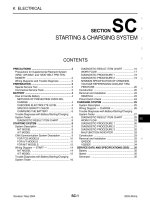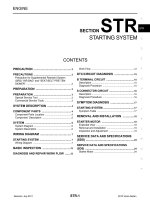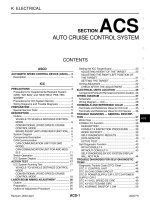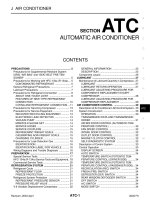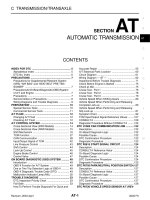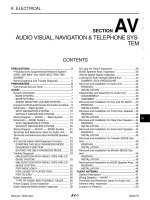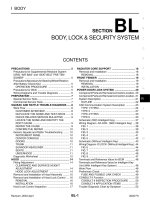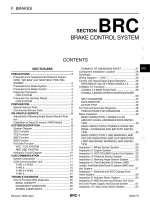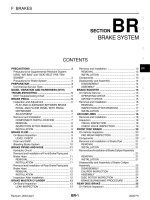SC hệ THỐNG KHỞI ĐỘNG, CHARGE TRÊN INFINITI FX35, FX45 2003
Bạn đang xem bản rút gọn của tài liệu. Xem và tải ngay bản đầy đủ của tài liệu tại đây (1.42 MB, 40 trang )
SC-1
STARTING & CHARGING SYSTEM
K ELECTRICAL
CONTENTS
C
D
E
F
G
H
I
J
L
M
SECTION SC
A
B
SC
Revision; 2004 April 2003 FX
STARTING & CHARGING SYSTEM
PRECAUTIONS 2
Precautions for Supplemental Restraint System
(SRS) “AIR BAG” and “SEAT BELT PRE-TEN-
SIONER” 2
Wiring Diagrams and Trouble Diagnosis 2
PREPARATION 3
Special Service Tools 3
Commercial Service Tools 3
BATTERY 4
How to Handle Battery 4
METHODS OF PREVENTING OVER-DIS-
CHARGE 4
CHECKING ELECTROLYTE LEVEL 5
SPECIFIC GRAVITY CHECK 5
CHARGING THE BATTERY 6
Trouble Diagnosis with Battery/Starting/Charging
System Tester 6
DIAGNOSTIC RESULT ITEM CHART 8
Removal and Installation 9
REMOVAL 9
INSTALLATION 9
STARTING SYSTEM 10
System Description 10
Wiring Diagram — START — 11
VK45DE ENGINE MODELS 11
VQ35DE ENGINE MODELS 12
Trouble Diagnosis with Battery/Starting/Charging
System Tester 13
DIAGNOSTIC RESULT ITEM CHART 13
WORK FLOW 14
DIAGNOSTIC PROCEDURE 1 15
DIAGNOSTIC PROCEDURE 2 16
MINIMUM SPECIFICATION OF CRANKING
VOLTAGE REFERENCING COOLANT TEM-
PERATURE 16
Removal and Installation 17
VK45DE ENGINE MODELS 17
VQ35DE ENGINE MODELS (2WD) 18
VQ35DE ENGINE MODELS (AWD) 19
Disassembly and Assembly 20
Inspection After Disassembly 22
PINION/CLUTCH CHECK 22
CHARGING SYSTEM 23
System Description 23
Wiring Diagram — CHARGE — 24
VK45DE ENGINE MODELS 24
VQ35DE ENGINE MODELS 25
Trouble Diagnosis with Battery/Starting/Charging
System Tester 26
DIAGNOSTIC RESULT ITEM CHART 27
WORK FLOW 28
DIAGNOSTIC PROCEDURE 1 29
DIAGNOSTIC PROCEDURE 2 30
DIAGNOSTIC PROCEDURE 3 31
DIAGNOSTIC PROCEDURE 4 32
DIAGNOSTIC PROCEDURE 5 33
MALFUNCTION INDICATOR 33
Removal and Installation 34
VK45DE ENGINE MODELS 34
VQ35DE ENGINE MODELS 35
Disassembly and Assembly 37
SERVICE DATA AND SPECIFICATIONS (SDS) 39
Battery 39
Starter 39
Alternator 39
SC-2
PRECAUTIONS
Revision; 2004 April 2003 FX
PRECAUTIONS PFP:00001
Precautions for Supplemental Restraint System (SRS) “AIR BAG” and “SEAT
BELT PRE-TENSIONER”
AKS00794
The Supplemental Restraint System such as “AIR BAG” and “SEAT BELT PRE-TENSIONER”, used along
with a front seat belt, helps to reduce the risk or severity of injury to the driver and front passenger for certain
types of collision. This system includes seat belt switch inputs and dual stage front air bag modules. The SRS
system uses the seat belt switches to determine the front air bag deployment, and may only deploy one front
air bag, depending on the severity of a collision and whether the front occupants are belted or unbelted.
Information necessary to service the system safely is included in the SRS and SB section of this Service Man-
ual.
WARNING:
● To avoid rendering the SRS inoperative, which could increase the risk of personal injury or death
in the event of a collision which would result in air bag inflation, all maintenance must be per-
formed by an authorized NISSAN/INFINITI dealer.
● Improper maintenance, including incorrect removal and installation of the SRS, can lead to per-
sonal injury caused by unintentional activation of the system. For removal of Spiral Cable and Air
Bag Module, see the SRS section.
● Do not use electrical test equipment on any circuit related to the SRS unless instructed to in this
Service Manual. SRS wiring harnesses can be identified by yellow and/or orange harnesses or
harness connectors.
Wiring Diagrams and Trouble Diagnosis AKS00796
When you read wiring diagrams, refer to the following:
● Refer to GI-15, "How to Read Wiring Diagrams" in GI section.
● Refer to PG-3, "POWER SUPPLY ROUTING CIRCUIT" for power distribution circuit in PG section.
When you perform trouble diagnosis, refer to the following:
● Refer to GI-11, "HOW TO FOLLOW TEST GROUPS IN TROUBLE DIAGNOSES" in GI section.
● Refer to GI-27, "How to Perform Efficient Diagnosis for an Electrical Incident" in GI section.
PREPARATION
SC-3
C
D
E
F
G
H
I
J
L
M
A
B
SC
Revision; 2004 April 2003 FX
PREPARATION PFP:00002
Special Service Tools AKS00797
Commercial Service Tools AKS00798
Tool number
Tool name
Description
J-44373 Model 620
Battery/Starting/Charging system
tester
SEL403X
Tool number
Tool name
Description
Power tool Loosening bolts and nuts
PBIC0190E
SC-4
BATTERY
Revision; 2004 April 2003 FX
BATTERY PFP:AYBGL
How to Handle Battery AKS00C6G
CAUTION:
● If it becomes necessary to start the engine with a booster battery and jumper cables, use a 12-volt
booster battery.
● After connecting battery cables, ensure that they are tightly clamped to battery terminals for good
contact.
METHODS OF PREVENTING OVER-DISCHARGE
The following precautions must be taken to prevent over-discharging
a battery.
● The battery surface (particularly its top) should always be kept
clean and dry.
● The terminal connections should be clean and tight.
● At every routine maintenance, check the electrolyte level.
This also applies to batteries designated as “low maintenance”
and “maintenance-free”.
● When the vehicle is not going to be used over a long period of
time, disconnect the negative battery cable.
● Check the charge condition of the battery.
Periodically check the specific gravity of the electrolyte. Keep a
close check on charge condition to prevent over-discharge.
MEL040F
MEL041F
MEL042F
BATTERY
SC-5
C
D
E
F
G
H
I
J
L
M
A
B
SC
Revision; 2004 April 2003 FX
CHECKING ELECTROLYTE LEVEL
WARNING:
Do not allow battery fluid to come in contact with skin, eyes, fabrics, or painted surfaces. After touch-
ing a battery, do not touch or rub your eyes until you have thoroughly washed your hands. If acid con-
tacts eyes, skin or clothing, immediately flush with water for 15 minutes and seek medical attention.
● Remove the cell plug using a suitable tool.
● Add distilled water up to the MAX level.
Sulphation
A battery will be completely discharged if it is left unattended
for a long time and the specific gravity will become less than
1.100. This may result in sulphation on the cell plates.
To determine if a battery has been “sulphated”, note its voltage
and current when charging it. As shown in the figure, less cur-
rent and higher voltage are observed in the initial stage of
charging sulphated batteries.
A sulphated battery may sometimes be brought back into ser-
vice by means of a long, slow charge, 12 hours or more, fol-
lowed by a battery capacity test.
SPECIFIC GRAVITY CHECK
1. Read hydrometer and thermometer indications at eye level.
2. Use the chart below to correct your hydrometer reading accord-
ing to electrolyte temperature.
Hydrometer Temperature Correction
MEL043F
PKIA2353E
MEL042FA
Battery electrolyte temperature °C (°F) Add to specific gravity reading
71 (160) 0.032
66 (150) 0.028
60 (140) 0.024
54 (130) 0.020
49 (120) 0.016
43 (110) 0.012
38 (100) 0.008
32 (90) 0.004
27 (80) 0
21 (70) −0.004
SC-6
BATTERY
Revision; 2004 April 2003 FX
CHARGING THE BATTERY
CAUTION:
● Do not “quick charge” a fully discharged battery.
● Keep the battery away from open flame while it is being charged.
● When connecting the charger, connect the leads first, then turn on the charger. Do not turn on the
charger first, as this may cause a spark.
● If battery electrolyte temperature rises above 55°C (131°F), stop charging. Always charge battery
at a temperature below 55°C (131°F).
Charging Rates
Do not charge at more than 50 ampere rate.
NOTE:
The ammeter reading on your battery charger will automatically decrease as the battery charges. This indi-
cates that the voltage of the battery is increasing normally as the state of charge improves. The charging amps
indicated above refer to initial charge rate.
● If, after charging, the specific gravity of any two cells varies more than 0.050, the battery should be
replaced.
Trouble Diagnosis with Battery/Starting/Charging System Tester AKS00C6F
CAUTION:
When working with batteries, always wear appropriate eye protection.
NOTE:
● To ensure a complete and thorough diagnosis, the battery, starter and alternator test segments must be
done as a set from start to finish.
● If battery surface charge is detected while testing, the tester will prompt you to turn on the headlamps to
remove the surface charge.
● If necessary, the tester will prompt you to determine if the battery temperature is above or below 0°C
(32°F). Choose the appropriate selection by pressing the up or down arrow button, then press “ENTER” to
make the selection.
16 (60) −0.008
10 (50) −0.012
4 (40) −0.016
−1 (30) −0.020
−7 (20) −0.024
−12 (10) −0.028
−18 (0) −0.032
Corrected specific gravity Approximate charge condition
1.260 - 1.280 Fully charged
1.230 - 1.250 3/4 charged
1.200 - 1.220 1/2 charged
1.170 - 1.190 1/4 charged
1.140 - 1.160 Almost discharged
1.110 - 1.130 Completely discharged
Battery electrolyte temperature °C (°F) Add to specific gravity reading
Amp Time
50 1 hour
25 2 hours
10 5 hours
5 10 hours
BATTERY
SC-7
C
D
E
F
G
H
I
J
L
M
A
B
SC
Revision; 2004 April 2003 FX
1. Turn off all loads on the vehicle electrical system. Clean or repair
as necessary.
2. Visually inspect the battery, battery terminals and cable ends
with ignition switch in “OFF” position.
NOTE:
The contact surface between the battery terminals, cable ends
and tester leads must be clean for a valid test. A poor connec-
tion will prevent testing and a “CHECK CONNECTION” mes-
sage will appear during the test procedures. If this occurs, clean
the battery post and terminals, reconnect them and restart the
test.
3. Connect the red tester lead clamp to the positive battery termi-
nal, and the black to the negative terminal.
4. The tester will turn on automatically. Using the arrow keys,
select “IN-VEHICLE” on the tester and then press the “ENTER”
key.
5. Locate the battery type and rating stamped or written on the top
case of the battery to be tested.
NOTE:
The battery type and rating will have either of the following.
CCA: Cold Cranking Amps (490 CCA, 550 CCA, etc.)
JIS: Japanese Industrial Standard.
Battery is stamped with a number such as:
80D26L: 80 (rank of output), D (physical size-depth), 26 (width
in cm). The last character L (post configuration) is not input into
the tester.
The tester requires the rating for the battery be entered exactly
as it is written or stamped on the battery. Do not attempt a CCA
conversion for JIS stamped batteries. JIS must be input directly.
6. Using the arrow and “ENTER” keys alternately, select the battery type and rating.
NOTE:
The tester lists five choices; CCA, JIS, IEC, DIN, and EN. Only use CCA or JIS.
7. Press “ENTER” to begin the test. Diagnosis results are dis-
played on the tester. Refer to SC-8, "
DIAGNOSTIC RESULT
ITEM CHART" .
SEL404X
SEL405X
SEL406X
SEL407X
SC-8
BATTERY
Revision; 2004 April 2003 FX
8. Press “ENTER”, then test output code is displayed. Record the
test output code on the repair order.
9. Toggle back to the “DIAGNOSTIC SCREEN” for test results.
NOTE:
● If necessary, the tester will ask the user to determine if the
battery has just been charged. Choose the appropriate selec-
tion by pressing the up or down arrow button and then press
the “ENTER” button to make the selection.
● When testing a battery installed in a vehicle that has recently
been driven, select “BEFORE CHARGE”.
● If the battery has just been slow charged due to a “CHARGE
& RETEST” decision by the tester, and the tester asks the user “BEFORE CHARGE/AFTER
CHARGE”, select “AFTER CHARGE”.
DIAGNOSTIC RESULT ITEM CHART
SEL576X
Diagnostic item Service procedure
GOOD BATTERY
Battery is OK, go to “Trouble Diagnosis”,“STARTING SYSTEM”. Refer to SC-13, "
Trouble
Diagnosis with Battery/Starting/Charging System Tester" .
REPLACE BATTERY
Replace battery.
Before replacing battery, clean the battery cable clamps and battery posts. Perform battery
test again with Battery/Starting/Charging system tester. If second test result is “Replace Bat-
tery”, then do so. Perform battery test again to confirm repair.
BAD CELL-REPLACE
Replace the battery. Perform battery test again with Battery/Starting/Charging system tester
to confirm repair.
GOOD-RECHARGE Perform the slow battery charging procedure. (Initial rate of charge is 10A for 12 hours.)
CHARGE & RETEST
Perform the slow battery charging. (Initial rate of charge is 10A for 12 hours.)
Perform battery test again with Battery/Starting/Charging system tester to confirm repair.
NOTE:
If the tester asks the user “BEFORE CHARGE/AFTER CHARGE”, select “AFTER
CHARGE”.
BATTERY
SC-9
C
D
E
F
G
H
I
J
L
M
A
B
SC
Revision; 2004 April 2003 FX
Removal and Installation AKS00C6E
REMOVAL
1. Remove hoodledge cover (right).
2. Disconnect negative battery cable and positive battery cable.
CAUTION:
When disconnecting, disconnect negative battery terminal
first.
3. Remove battery fix frame mounting nuts and battery fix frame.
4. Remove relay box from bracket.
5. Remove battery.
INSTALLATION
Install in the reverse order of removal.
CAUTION:
When connecting, connect positive battery cable first.
PKIA2805E
PKIA2806E
Battery fix frame mounting nut
: 3.9 N·m (0.4 kg-m, 35 in-lb)
Battery terminal nut
: 5.4 N·m (0.55 kg-m, 48 in-lb)
SC-10
STARTING SYSTEM
Revision; 2004 April 2003 FX
STARTING SYSTEM PFP:23300
System Description AKS00C6D
Power is supplied at all times:
● through 40A fusible link (letter F, located in the fuse and fusible link box)
● to ignition switch terminal 1
● through 15A fuse (No. 78, located in the IPDM E/R)
● to CPU of IPDM E/R
● through 10A fuse (No. 71, located in the IPDM E/R)
● to CPU of IPDM E/R.
When the selector lever in the P or N position, power is supplied:
● from TCM, and through A/T assembly terminal 9
● to IPDM E/R terminal 53.
Ground is supplied:
● to IPDM E/R terminals 38, 50 and 60
● from body grounds E21, E50 and E51.
With the ignition switch in the START position, and provided that the IPDM E/R receives a starter relay ON sig-
nal from the CAN lines, the IPDM E/R is energized and power is supplied:
● from ignition switch terminal 5
● to IPDM E/R terminal 4 and
● through IPDM E/R terminal 3
● to starter motor terminal 1.
The starter motor plunger closes and provides a closed circuit between the battery and starter motor. The
starter motor is grounded to the engine block. With power and ground supplied, cranking occurs and the
engine starts.
STARTING SYSTEM
SC-11
C
D
E
F
G
H
I
J
L
M
A
B
SC
Revision; 2004 April 2003 FX
Wiring Diagram — START — AKS00C6C
VK45DE ENGINE MODELS
TKWM0548E
SC-12
STARTING SYSTEM
Revision; 2004 April 2003 FX
VQ35DE ENGINE MODELS
TKWM0549E
STARTING SYSTEM
SC-13
C
D
E
F
G
H
I
J
L
M
A
B
SC
Revision; 2004 April 2003 FX
Trouble Diagnosis with Battery/Starting/Charging System Tester AKS00C6B
NOTE:
To ensure a complete and thorough diagnosis, the battery, starter and alternator test segments must be done
as a set from start to finish.
1. Turn off all loads on the vehicle electrical system.
2. Perform battery test with Battery/Starting/Charging system
tester. Refer to SC-6, "
Trouble Diagnosis with Battery/Starting/
Charging System Tester" .
3. Press “ENTER” to begin the starting system test.
4. Start the engine.
5. Diagnosis result is displayed on the tester. Refer to SC-13,
"DIAGNOSTIC RESULT ITEM CHART" .
NOTE:
● If the starter performs normally but the engine does not start,
perform engine diagnosis.
● For intermittent “NO CRANK” or “NO STARTER OPERA-
TION” incidents, refer to SC-16, "
DIAGNOSTIC PROCE-
DURE 2" .
DIAGNOSTIC RESULT ITEM CHART
SEL408X
SEL409X
SEL410X
Diagnostic item Service procedure
CRANKING VOLTAGE NORMAL
Go to SC-14, "
WORK FLOW" .
CRANKING VOLTAGE LOW
CHARGE BATTERY
Perform the slow battery charging procedure. (Initial rate of charge is 10A for 12 hours.) Per-
form battery test again with Battery/Starting/Charging system tester. Refer to SC-6, "Trouble
Diagnosis with Battery/Starting/Charging System Tester" .
REPLACE BATTERY
Before replacing battery, clean the battery cable clamps and battery posts. Perform battery
test again with Battery/Starting/Charging system tester. Refer to SC-6, "
Trouble Diagnosis
with Battery/Starting/Charging System Tester" . If second test result is “REPLACE BAT-
TERY”, then do so. Perform battery test again to confirm repair.
SC-14
STARTING SYSTEM
Revision; 2004 April 2003 FX
WORK FLOW
*1 SC-6, "Trouble Diagnosis with Bat-
tery/Starting/Charging System
Tester".
*2 SC-16, "MINIMUM SPECIFICATION
OF CRANKING VOLTAGE REFER-
ENCING COOLANT TEMPERA-
TURE".
*3 SC-15, "
DIAGNOSTIC PROCE-
DURE 1".
*4 SC-16, "DIAGNOSTIC PROCE-
DURE 2".
SKIB0227E
STARTING SYSTEM
SC-15
C
D
E
F
G
H
I
J
L
M
A
B
SC
Revision; 2004 April 2003 FX
DIAGNOSTIC PROCEDURE 1
Check “B” Terminal Circuit
1. CHECK POWER SUPPLY FOR STARTER MOTOR “B” TERMINAL
1. Remove fuel pump fuse.
2. Crank or start the engine (where possible) until the fuel pressure is released.
3. Turn ignition switch OFF.
4. Make sure that the starter motor B terminal E313 terminal 2 (B) (VK45DE) or (B/R) (VQ35DE) connection
is clean and tight.
5. Check voltage between starter motor B terminal E313 terminal 2
(B) (VK45DE) or (B/R) (VQ35DE) and ground using a digital cir-
cuit tester.
OK or NG
OK >> GO TO 2.
NG >> Check harness between the battery and the starter
motor for open circuit.
2. CHECK BATTERY HARNESS CONNECTION (VOLTAGE DROP TEST)
Check voltage between starter motor B terminal E313 terminal 2 (B)
(VK45DE) or (B/R) (VQ35DE) and battery positive terminal using a
digital circuit tester.
OK or NG
OK >> GO TO 3.
NG >> Check harness between the battery and the starter
motor for poor continuity.
3. CHECK STARTER MOTOR GROUND CIRCUIT (VOLTAGE DROP TEST)
1. Turn ignition switch OFF.
2. Check voltage between starter motor case and battery negative
terminal using a digital circuit tester.
OK or NG
OK >> Starter motor “B” terminal circuit is OK. Further inspec-
tion necessary. Refer to SC-14, "
WORK FLOW" .
NG >> Check the starter motor case and ground for poor conti-
nuity.
Battery voltage should exist.
PKIA2842E
When the ignition switch is in START position,
Voltage: Less than 0.5V
PKIA2370E
When the ignition switch is in START position,
Voltage: Less than 0.2V
PKIA2943E
SC-16
STARTING SYSTEM
Revision; 2004 April 2003 FX
DIAGNOSTIC PROCEDURE 2
Check “S” Connector Circuit
1. CHECK POWER SUPPLY FOR STARTER MOTOR “S” CONNECTOR
1. Remove fuel pump fuse.
2. Crank or start the engine (where possible) until the fuel pressure is released.
3. Turn ignition switch OFF.
4. Disconnect starter motor S connector.
5. Check voltage between starter motor harness connector E312
(VK45DE) or F33 (VQ35DE) terminal 1 (B) and ground using a
digital circuit tester.
OK or NG
OK >> GO TO 2.
NG >> Check the following.
● 40A fusible link (letter F , located in fuse and fusible
link box)
● Ignition switch
● Starter relay [within the IPDM E/R (intelligent power distribution module engine room)].
● Harness for open or short
2. CHECK “S” TERMINAL CONNECTION (VOLTAGE DROP TEST)
1. Turn ignition switch OFF.
2. Connect starter motor S connector.
3. Check voltage between starter motor harness connector E312
(VK45DE) or F33 (VQ35DE) terminal 1 (B) and battery positive
terminal using a digital circuit tester.
OK or NG
OK >> Starter motor “S” connector circuit is OK. Further inspec-
tion necessary. Refer to SC-14, "
WORK FLOW" .
NG >> Check harness between the battery and the starter
motor “S” connector for poor continuity.
MINIMUM SPECIFICATION OF CRANKING VOLTAGE REFERENCING COOLANT TEMPERA-
TURE
When the ignition switch is in START position,
Battery voltage should exist.
PKIA2807E
When the ignition switch is in START position,
Voltage: Less than 1V
PKIA2808E
Engine coolant temperature Voltage V
−30°C to −20°C (−22°F to −4°F) 8.4
−19°C to −10°C (−2°F to 14°F) 8.9
−9°C to 0°C (16°F to 32°F) 9.3
More than 1°C (More than 34°F) 9.7
STARTING SYSTEM
SC-17
C
D
E
F
G
H
I
J
L
M
A
B
SC
Revision; 2004 April 2003 FX
Removal and Installation AKS00C6A
VK45DE ENGINE MODELS
Removal
1. Disconnect negative battery cable.
2. Remove engine front and rear undercover, using power tools.
3. Disconnect S connector.
4. Remove B terminal nut.
5. Remove starter motor mounting bolts.
6. Loosen A/T fluid cooler tube clip bolts. Refer to AT-269,
"TRANSMISSION ASSEMBLY" in “AUTOMATIC TRANSMIS-
SION (A/T)” section.
7. Remove starter motor to the direction of under side the vehicle.
Installation
Install in the reverse order of removal.
CAUTION:
Be sure to tighten B terminal nut carefully.
1. Starter motor 2. Starter motor mounting bolt 3. B terminal harness
4. B terminal nut 5. S connector 6. Cylinder block
PKIA2809E
PKIA2810E
SC-18
STARTING SYSTEM
Revision; 2004 April 2003 FX
VQ35DE ENGINE MODELS (2WD)
Removal
1. Disconnect negative battery cable.
2. Remove engine rear undercover, using power tools.
3. Disconnect S connector.
4. Remove B terminal nut.
5. Remove starter motor mounting bolts and harness clip bracket,
using power tools.
6. Remove starter motor to the direction of under side the vehicle.
Installation
Install in the reverse order of removal.
CAUTION:
Be sure to tighten B terminal nut carefully.
1. Starter motor mounting bolt 2. Harness clip bracket 3. S connector
4. B terminal nut 5. B terminal harness 6. Starter motor
7. Oil pan
PKIA3127E
PKIA2812E
STARTING SYSTEM
SC-19
C
D
E
F
G
H
I
J
L
M
A
B
SC
Revision; 2004 April 2003 FX
VQ35DE ENGINE MODELS (AWD)
Removal
1. Disconnect negative battery cable.
2. Remove engine front and rear undercover, using power tools.
3. Disconnect S connector.
4. Remove B terminal nut.
5. Remove starter motor mounting bolts.
6. Remove starter motor to the direction of under side the vehicle.
Installation
Install in the reverse order of removal.
CAUTION:
Be sure to tighten B terminal nut carefully.
1. Starter motor mounting bolt 2. Oil pan 3. Starter motor
4. B terminal harness 5. B terminal nut 6. S connector
PKIA2843E
PKIA2844E
SC-20
STARTING SYSTEM
Revision; 2004 April 2003 FX
Disassembly and Assembly AKS00C69
1. Nut 2. Magnetic switch assembly 3. Adjusting plate
4. Packing 5. Plate 6. Shift lever
7. Front bracket assembly 8. Yoke assembly 9. Armature assembly
10. Washer 11. Rear bearing 12. Brush holder assembly
13. Rear bracket assembly 14. Through-bolt 15. Cover
16. Packing 17. Ball 18. Shaft gear assembly
19. Clutch gear assembly 20. Pinion stopper 21. Stopper clip
PKIA3126E
STARTING SYSTEM
SC-21
C
D
E
F
G
H
I
J
L
M
A
B
SC
Revision; 2004 April 2003 FX
1. Magnetic switch assembly 2. Dust cover kit 3. Shift lever set
4. Center bracket (A) 5. Yoke assembly 6. Armature assembly
7. Brush holder assembly 8. Thrust washer 9. Rear cover assembly
10. Through-bolt 11. Internal gear 12. Planetary gear
13. Pinion shaft 14. Packing 15. Thrust washer
16. Center bracket (P) 17. E-ring 18. Pinion assembly
19. Ball bearing 20. Caul 21. Gear case assembly
PKIA2814E
SC-22
STARTING SYSTEM
Revision; 2004 April 2003 FX
Inspection After Disassembly AKS00C68
PINION/CLUTCH CHECK
1. Inspect pinion teeth.
● Replace pinion if teeth are worn or damaged. (Also check condition of ring gear teeth.)
2. Inspect reduction gear teeth.
● Replace reduction gear if teeth are worn or damaged. (Also check condition of armature shaft gear
teeth.)
3. Check to see if pinion locks in one direction and rotates smoothly in the opposite direction.
● If it locks or rotates in both directions, or unusual resistance is evident, replace.
1. Magnetic switch assembly 2. Dust cover kit 3. Shift lever set
4. Center bracket (A) 5. Yoke assembly 6. Armature assembly
7. Brush holder assembly 8. Thrust washer 9. Rear cover assembly
10. Through-bolt 11. Internal gear 12. Planetary gear
13. Pinion shaft 14. Packing 15. Thrust washer
16. Center bracket (P) 17. E-ring 18. Pinion assembly
19. Ball bearing 20. Caul 21. Gear case assembly
PKIA2845E
CHARGING SYSTEM
SC-23
C
D
E
F
G
H
I
J
L
M
A
B
SC
Revision; 2004 April 2003 FX
CHARGING SYSTEM PFP:23100
System Description AKS00C67
The alternator provides DC voltage to operate the vehicle's electrical system and to keep the battery charged.
The voltage output is controlled by the IC regulator.
Power is supplied at all times:
● through 10A fuse (No. 33, located in the fuse and fusible link box)
● to alternator terminal 4 (S).
Terminal B supplies power to charge the battery and operate the vehicle's electrical system. Output voltage is
controlled by the IC regulator at terminal 4 (S) detecting the input voltage.
The charging circuit is protected by the 120A fusible link (VK45DE and VQ35DE AWD).
The alternator is grounded to the engine block.
With the ignition switch in the ON or START position, power is supplied:
● through 10A fuse [No. 14, located in the fuse block (J/B)]
● to combination meter terminal 7 for the charge warning lamp.
Ground is supplied:
● to combination meter terminal 2
● through alternator terminal 3 (L)
● to alternator terminal E (VK45DE) or through body ground (VQ35DE)
● through body ground E304 (VK45DE).
With power and ground supplied, the charge warning lamp will illuminate. When the alternator is providing suf-
ficient voltage with the engine running, the ground is opened and the charge warning lamp will go off.
If the charge warning lamp illuminates with the engine running, a malfunction is indicated.
SC-24
CHARGING SYSTEM
Revision; 2004 April 2003 FX
Wiring Diagram — CHARGE — AKS00C66
VK45DE ENGINE MODELS
TKWM0550E
CHARGING SYSTEM
SC-25
C
D
E
F
G
H
I
J
L
M
A
B
SC
Revision; 2004 April 2003 FX
VQ35DE ENGINE MODELS
TKWM0551E
